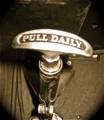|
Re: Tire Pressure
|
||||
|---|---|---|---|---|
|
Not too shy to talk
|
32 max.
Posted on: 2013/3/24 21:05
|
|||
|
1952 Packard 200
|
||||
|
||||
|
Re: Tire Pressure
|
||||
|---|---|---|---|---|
|
Home away from home
|
While on the subject of tires and tire pressure, I found this article to be interesting that Auto Trader Classics posted from interviews with Corky Coker (Coker Tires), John Kelsey (Kelsey Tires) and other tire brand representatives.
autotraderclassics.com/car-article/Bias_Ply+Or+Radial%3F-71273.xhtml Since I'm getting ready to swap out those despicable "Blazer" wheel rims for a set of freshly painted originals on my Clipper, I wanted to obtain as much information as I could on the Radial vs. Bias debate. Reason being is that even though they are only the 1.6" wide whitewalls, the radial tires that came on the car are like brand new and I couldn't see spending the money on new tires until I wear these out then I'll decide whether I want to replace them with Radials or Bias. It was also interesting that Corky suggested cranking the pressures up in the radials to 36-40 Lbs.
Posted on: 2013/3/25 7:55
|
|||
|
||||
|
Re: Tire Pressure
|
||||
|---|---|---|---|---|
|
Home away from home
|
Quote:
Dave I appreciate your concern, both for me and fellow enthusiasts. The advice I've been taking came directly from the tire manufacturer owner, also a super-big-time old-car enthusiast, engineer, and one who did a lot of touring at high speeds. I will not mention his name. I completely rebuilt the front end of my car, shocks, springs, etc. There is absolutely no wander, except in severely deep ruts, in which case I automatically slow down or change lanes. With a tight rebuilt front-end, even if it does wander, it is easy to keep under control. There is less heat build-up at the higher pressure, and since I drive 70-75mph on the freeway, I am more confident in the tire than if it were at 25psi.
Posted on: 2013/3/25 10:47
|
|||
|
West Peterson
1930 Packard Speedster Eight boattail (SOLD) 1940 Packard 1808 w/Factory Air (SOLD) 1947 Chrysler Town and Country sedan 1970 Camaro RS 1936 Cord phaeton packardinfo.com/xoops/html/modules/newbb/viewtopic.php?topic_id=4307&forum=10 aaca.org/ |
||||
|
||||
|
Re: Tire Pressure
|
||||
|---|---|---|---|---|
|
Home away from home

|
West Peterson,
Just out of curisoity what is the tire pressure reccomendation/range moulded onto the side of the tires. I prefer higher tire pressure but have never tried as high as 40 psi.
Posted on: 2013/3/25 11:43
|
|||
|
VAPOR LOCK demystified: See paragraph SEVEN of PMCC documentaion as listed in post #11 of the following thread:f
packardinfo.com/xoops/html/modules/newbb/viewtopic.php?topic_id=7245 |
||||
|
||||
|
Re: Tire Pressure
|
||||
|---|---|---|---|---|
|
Home away from home
|
I have slightly oversized Firestones on my 1940 Packard... supposed to be 7.00s and i have 7.50s (kind of like a second overdrive??). The car is in storage right now, so I can't tell you what the printed rating is.
Posted on: 2013/3/25 12:17
|
|||
|
West Peterson
1930 Packard Speedster Eight boattail (SOLD) 1940 Packard 1808 w/Factory Air (SOLD) 1947 Chrysler Town and Country sedan 1970 Camaro RS 1936 Cord phaeton packardinfo.com/xoops/html/modules/newbb/viewtopic.php?topic_id=4307&forum=10 aaca.org/ |
||||
|
||||
|
Re: Tire Pressure
|
||||
|---|---|---|---|---|
|
Home away from home

|
As a side note:
Back in the mid 70's, i'll peg ca. 1975, when radials first became optional (US) or widely accepted as available, they were ran about 1/2 flat according to mfg'er and oem specs. The half flat condition was conspicuous upon visula inspection. That lasted about 5 to 7 years or production. Somewhere about 1980 to present they are now inflated to something that resembles a fully inflated tire.
Posted on: 2013/3/25 13:16
|
|||
|
VAPOR LOCK demystified: See paragraph SEVEN of PMCC documentaion as listed in post #11 of the following thread:f
packardinfo.com/xoops/html/modules/newbb/viewtopic.php?topic_id=7245 |
||||
|
||||
|
Re: Tire Pressure
|
||||
|---|---|---|---|---|
|
Home away from home

|
"I was looking at some old articles by Tom McCahill and in none of them does he talk about going to the local gas station and cranking up tire pressures because he is about to drive from Chicago to Las Vegas as fast as the car will go. "
I'm a McCahill fan from way back. Over the years, have found his advice and opinions on old cars (new when he tested them) to be valuable and instructive. He had some strong words to say about the new low pressure tires that came out in about 1951. They were made of synthetic rubber and were supposed to be inflated to 24PSI. He considered them inferior to prewar tires made of natural rubber, and the low inflation pressure, while it gave a soft ride, made the car dangerous in an emergency. A fast maneuver at speed could cause the car to roll, skid, and in extreme cases the tire could roll right off the rim and deflate. He ran his own tires at 32PSI which was safer, gave firmer handling, better gas mileage and longer tire life. He also commented that if you could feel a difference in ride quality you must have been sitting on cold rocks too long lol. He also suggested owner's manuals should contain 2 tire pressures, one for low speed around town use, and another 4 to 6 PSI higher for high speed, highway trips. He felt underinflated tires not only contributed to dangerous handling, but could overheat and blow out after prolonged driving at speed. All tire and auto manufacturers later took up this suggestion
Posted on: 2013/3/25 22:04
|
|||
|
||||
|
Re: Tire Pressure
|
||||
|---|---|---|---|---|
|
Home away from home

|
T,l,OT (Totally, like, Off Topic):
This topic has brought to mind one reason why I love this site (in a platonic way). And that reason is the great discussions about topics that many would consider arcane, but in reality are critical to our enjoyment, safety, and interest in these cars. Given the right group of folks, these topics are raised to the prominence that they deserves. That is what happens here at PackardInfo. This online forum has attracted people that provide this level of discussion. We have to thank Big Kev for this and all that it garners. It is his design that has brought us and held us. If you agree, I encourage you to scroll down, look to the right, and click on the PayPal donation button. Really, just scroll on down and click. You will benefit in Karmic, and Packard, points. Cheers, Tom p.s. Big Kev, and PackardInfo.com, have not provided any instruction or incentive, besides a great website, for me to make this suggestion. I am just an enthusiastic customer.
Posted on: 2013/3/26 11:40
|
|||
|
||||
|
Re: Tire Pressure
|
||||
|---|---|---|---|---|
|
Home away from home
|
Amen, Bishop O'Toole. I carried the 32 psi maximum cold pressure in my '40 120's 6.50/16 Denman bias plies. When i sold the car after putting a total 10,800 miles on it since rebuilding it bumper to bumper, the tires still retained ALL their tread. There was NO wear. None.
Tom McCahill spoke the truth. Other than Click 'n' Clack, mainstream America'll never again enjoy such an upbeat, entertaining, accurate a straight shooter. A little off topic, but i doublechecked my gas mileage in that overdrive car using a calculator, and got 22.5 mpg, everything stock according to East Grand Avenue, timing either 6 degrees BTDC, no more than a degree or so more. The sole deviation was i had the 4.09:1 rear axle per non-overdrive models in lieu of the 4.36. However, the 7.00/15 Denmans i ran on my '47 Super Clipper quickly wore down by 9 or 10,000 miles, despite proper front end alignment, etc. But remember, the cars of 1941-47 were heavier than '40 models industry-wide, and the 7.00/15 introduced for '41 solely to lower cars' profiles, despite having a slightly higher load rating than 6.50/16, still left and leave you with less payload margin. I now run bias ply-sized 7.00/15 Bridgestone LT R230 radials on my '47 Super. Yokohama offers a similar tire of identical specifications, and until the early aughts, so did Michelin. So i've the best of all worlds: historically correct bias ply-sized blackwalls with all the advantages of radials. What amazed me was the first time i put on the brakes coming off the freeway in town traffic, the car stopped faster with radials, too. These LT radials will take pressures up to 60 or more lbs. depending on vehicle weight, but most of us running such sneakers on '40s Packards and Cadillacs have found 42 psi a good figure. I run 44, but that's just me. Right smooth, velvety ride, the single best thing you can do for an old car after overdrive and a prelube device for full oil pressure after the car's been sitting. In fairness, few of us here gathered really remember the very best quality bias plies in the day. I'm told these were vastly better than the crappy old car hobby bias plies people in third world nations wouldn't buy but old car cuckoos, as the late Jean Shepherd called us and himself, will gladly cough up obscene amounts of money for so long as they're plastered with wide whitewalls, which most people considered tacky on high end road cars originally. As with batteries, i'm interested strictly in the car, what Packard built, and giving it every edge possible while keeping it stock--- just well-tuned, maintained, if tweaked, only per an obscure Packard Service Counselor issued to dealers. Regardless of tires or pressure, the hard truth is that most old cars today are cosmetically restored worn out bombs with rebuilt engines, because everyone likes rebuilding engines, while overlooking all the other grueling, arcane but vital bits. The proceeding are but my personal experience, and i bow as always to Drs. Cole and t'others, who work and have worked on myriad old cars, Packards among them, over the decades.
Posted on: 2013/3/26 14:55
|
|||
|
||||








